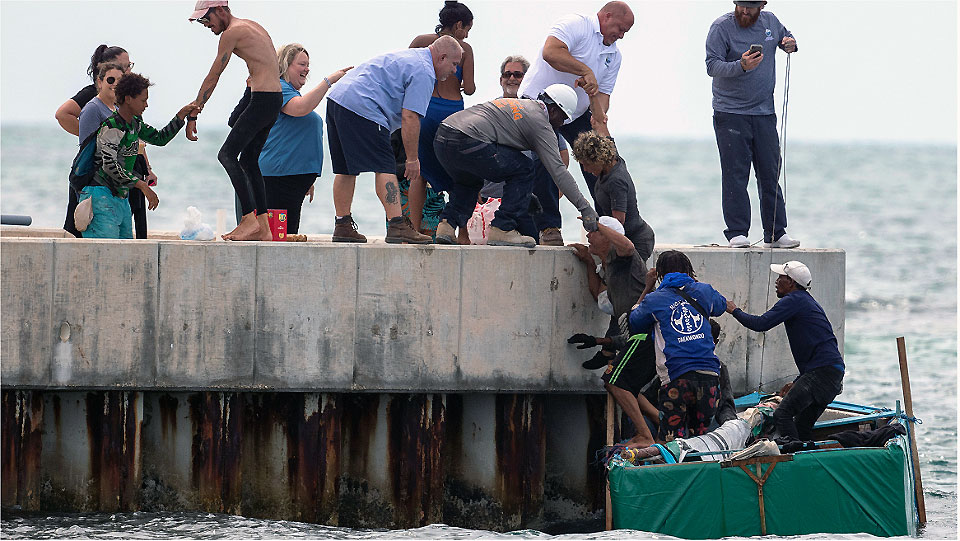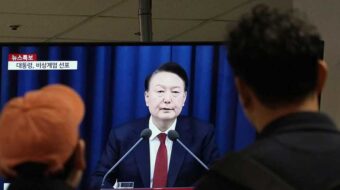
“Maybe if you had printed more about the operation, you would have saved us from a colossal mistake,” President John F. Kennedy berated New York Times editor Turner Catledge. The Times and the U.S. media generally had glossed over widely-known preparations for the Bay of Pigs attack in April 1961. Catledge had removed the revealing substance of reporter Tad Szulc’s detailed news story ten days beforehand.
Media silence has attended other Cuba-related developments over the years. Many U.S. progressives and liberals also tend to mention little about U.S-Cuban affairs, the U.S. economic blockade of Cuba being one example.
The Cuban Adjustment Act (CAA), which concerns Cubans migrating to the United States, receives little attention, while fuss and fury grow over an unprecedented number of migrants, Cubans among them, crossing the U.S. southern border now. Officials there apprehended 1.8 million migrants between October 2021 and August 2022.
Most respondents to an NPR/Ipsos poll believe an “invasion” is taking place. Anti-migrant measures have led to political division and stalemate. Sens. Lindsey Graham and Ted Cruz sent a letter to Department of Homeland Security Secretary Alejandro Mayorkas on Oct. 5 in which they claimed the Biden administration’s migration policies represent “gross dereliction of duty … violation of your oath of office …[and] grounds for impeachment.”
Cubans, enabled by the CAA, find welcome in the United States. That 1966 law allows Cuban immigrants and their immediate families to easily become permanent U.S. residents. To be eligible, the Cuban migrant on arrival has to be “inspected, admitted, or paroled.” He or she waits for one year while receiving social services, then applies for permanent residency, and gains a work permit. Other immigrants must wait five years to apply.
Why is Cuban immigration encouraged? The idea may have been to display the failure of a Communist government through Cubans leaving, or fracture popular unity in Cuba through emigration, or strengthen the Cuban-American voting bloc through new Cuban arrivals.
Numbers of Cuban migrants have increased recently. There were 9,822 “southwest border encounters” of border officials with Cubans in fiscal year 2020, 38,674 in FY 2021, and 174,674 Cubans in the FY ending on October 1, 2022. Between October 2021 and June, border officials detained more than 1,300 Cubans arriving by sea in Florida.
Cubans have been enduring shortages, high prices, and low income due mostly to the U.S. economic blockade and cutbacks on the remittances Cuban-Americans send to family members on the island. That’s one set of reasons for leaving Cuba.
Additionally, Nicaragua in November 2021 began allowing Cubans to enter without an entry visa. Migrants can now start on their trip closer to the border than, as before, having to travel through South America.
And most of the 20,000 Cubans who would have entered the United States annually, as authorized by a 1994 bi-national agreement, have not done so. That’s because almost no processing of entry visas has taken place since 2017 when the State Department recalled most of its Embassy staff in Havana. That was in response to a mysterious neurological syndrome afflicting U.S. diplomats and staff.
Few Cubans have been able to afford travel to U.S. embassies in other countries to secure visas. Consequently, departing Cubans have resorted to irregular means. The State Department has recently begun to send diplomatic staff back to its Havana Embassy.
New rules are in place. The Obama administration in 2017 ended the government’s “wet foot, dry foot” policy, in force since 1995. During that period, Cubans apprehended at sea were returned to Cuba. Those who arrived and touched U.S. soil could stay and eventually gain permanent residency status.
Cuban migrants crossing at the U.S. southern border still receive preferential treatment. Unable to show the required evidence of “lawful entry,” they benefit from creative arrangements that convert an irregular entry into a legal one.
Presently, “nearly 98%” of Cuban migrants entering the United States stay. Border officials apply public health (anti-COVID) regulations known as Title 42 to all would-be immigrants. They immediately exclude half of them, but not the Cubans. Excluded migrants wait in Mexico or elsewhere for immigration judges to decide on their applications for asylum.
Some of the entering Cubans receive “humanitarian parole.” Under CAA regulations, that status qualifies as “lawful entry” and the migrant is able to wait for a year in the United States and then apply for permanent residency—and usually receive it.
Other Cubans not receiving humanitarian parole also remain in the United States by means of a “bond” requiring them to appear before immigration judges “where they can launch a defense for staying.” Most migrants in this group whose appeals are successful can count on gaining permanent residency.
A few have been unsuccessful, and that group received good news on Feb. 23, 2022. The U.S. Citizenship and Immigration Services announced that Cuban migrants whose appeal for permanent residence had failed could try again, with likely success. The agency was responding to an immigration court ruling in 2021 that any release of Cuban migrants from custody at the border, whatever the circumstances, actually does represent “lawful entry” or parole, as required by the CAA.
Most of the Cubans exiting from their country are young adults and children. They benefited from the high-quality education, healthcare, and social support that was their birthright. Their energy, talents, labor, and potential commitment would no longer be contributing to Cuba’s national project of development and recovery. Their departure, one supposes, weakens the bonds of family life in Cuba and thereby makes Cuban society less cohesive.
The U.S. leadership class likely has little regret. The U.S. intention, after all, is to cause distress in Cuba leading to regime change. Moreover, the U.S. economic blockade of Cuba, the military occupation of territory in Guantanamo, destabilizing interventions inside Cuba, and the CAA, taken together, add up to attacks on Cuba’s independence and national sovereignty. The silence of the media and of political activists on these matters takes on an ominous quality, that of complicity with crimes.
The community of nations enables the United Nations to deal with international crimes. Under the United Nations Charter, the Security Council may confront “any threat to the peace, breach of the peace, or act of aggression” of one nation against another. The General Assembly in 1965 unanimously approved Resolution 2131, which states that “No State has the right to intervene, directly or indirectly, for any reason whatever, in the internal or external affairs of any State.”
What situations would these authorizations be applied to, if not to the instances recited here of U.S. aggression against Cuba?











